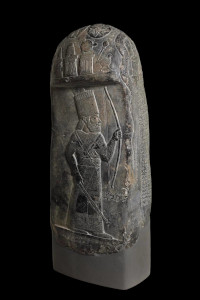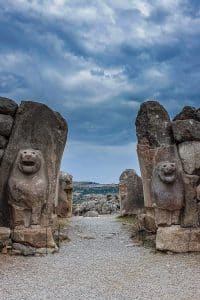
Not a Friend of ASOR yet? Sign up here to receive ANE Today in your inbox weekly!

April 2024
Vol. 12, No. 4
From Words into Pictures: Adapting 1177 BC for Comics
By Glynnis Fawkes
When Princeton University Press editor Rob Tempio first suggested a graphic adaptation of Eric Cline’s 1177 BC, I wasn’t sure how it could be done. Creating a comics page is a puzzle: a balance of text, action, and design. How would I muster the elements of comics to recreate the complex story of 1177 BC? But when I read — and couldn’t put down — Eric’s book, I knew I could create this adaptation, and even better, it would be an opportunity to create a visual world I would have devoured as a teenager fascinated by antiquity.
The key was that Eric constructed 1177 BC as a series of stories, each of which served as evidence for the larger story of the interconnected cultures of the Late Bronze Age. Such a narrative approach creates a vivid picture of that world and its collapse. Eric’s skill in weaving together threads of evidence made it possible for me to envision each page composition as a combination of maps, artifacts, and interactions of real and imagined characters.
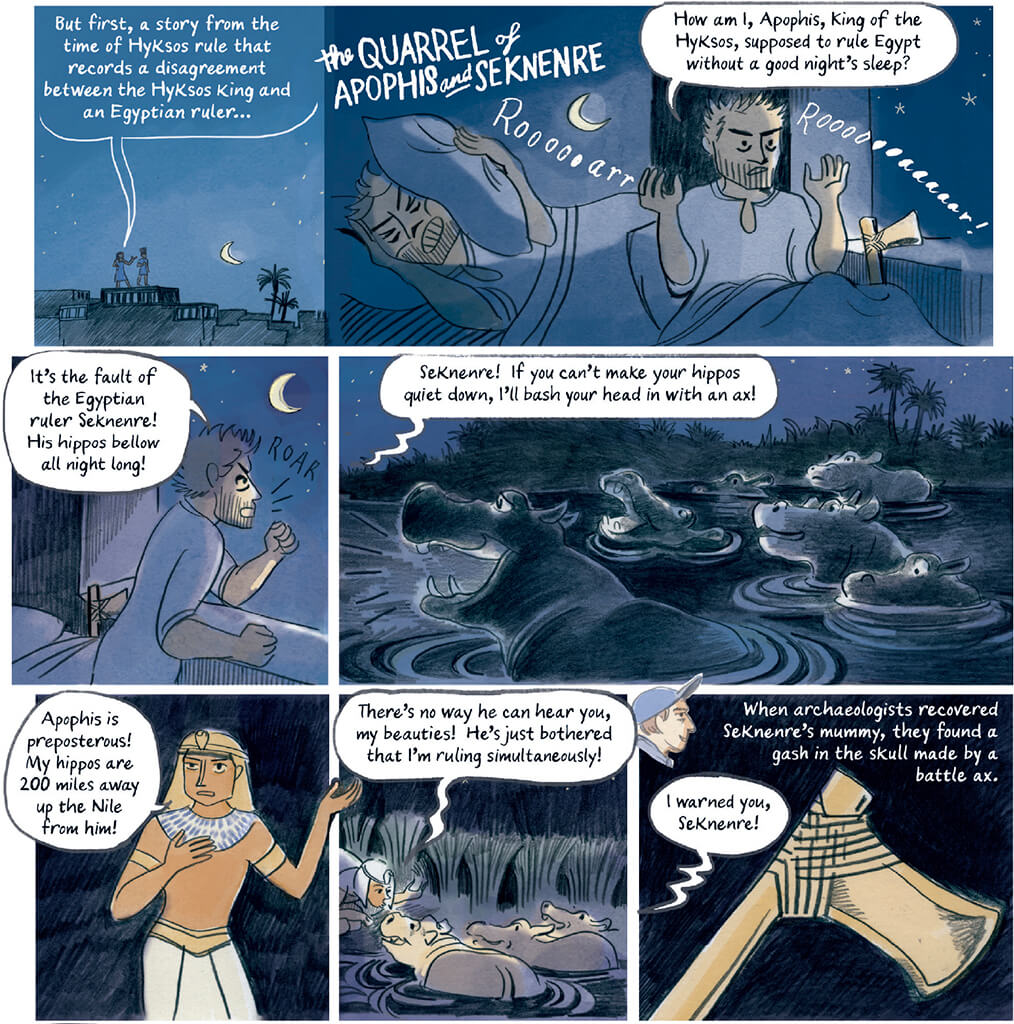
The story of the quarrel between Apophis and Seknenre. Text & illustration by Glynnis Fawkes.
Some stories come from textual evidence: the hippos of Seknenre; the returned Minoan shoes; and the angry widowed Egyptian queen requesting a Hittite prince to marry. Some stories are archaeological: skeletons crushed under buildings destroyed by earthquakes. Often they’re both textual and archaeological: clay tablets calling for help from Ugarit recovered from under a thick destruction layer; Thutmose III’s account of his attack on Megiddo and the evidence for destruction at the site itself. I relied on books and Google image searches for depictions of royalty, iconography, clothing, and jewelry of the time. I wanted to include non-royal people (in not-so-fancy outfits) who witnessed and suffered through the end of civilization. There is little evidence for the many people whose lives were swept up in events beyond their control — and so imagining vignettes of what it might have been like is a way of empathizing from this great distance in time.
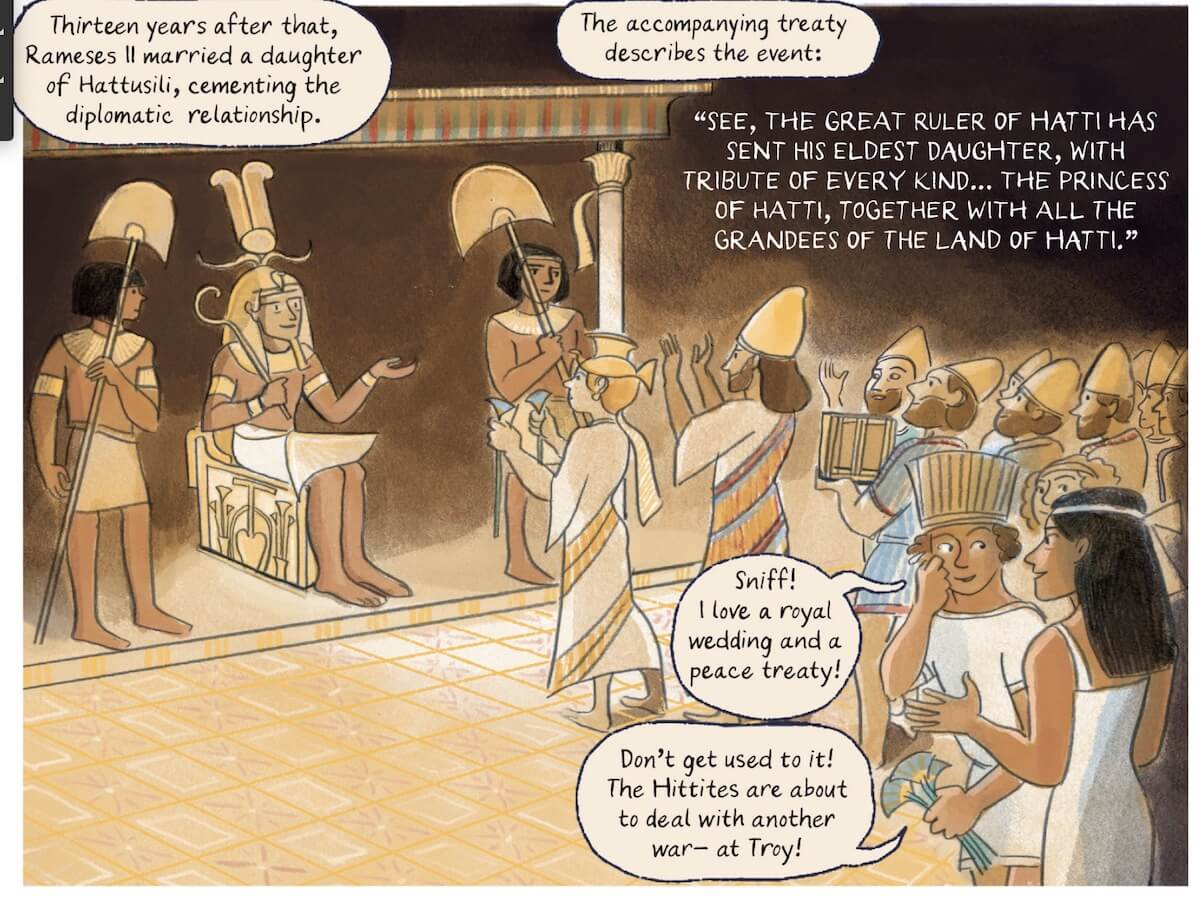
The arrival of the daughter of Hattusili at the court of Rameses II. Text and illustration by Glynnis Fawkes.
My MFA in painting and background as an archaeological illustrator on sites around the Eastern Mediterranean gave me a context for many of the places and artifacts in the book. I’ve made technical illustrations for publication of Cypriot, Minoan, and other types of pottery sherds, and have been lucky to walk the ruined streets of Troy, Ugarit, Mycenae, Knossos, Byblos, Megiddo, and see the mortuary temple of Ramses III at Medinet Habu that depicts the battles of the Sea Peoples. After a Fulbright to Cyprus, I published a book of paintings of Cypriot sites, and a book of cartoons about Cypriot archaeology — my earliest jokes about the Sea Peoples date to 22 years ago. Since I was in high school, I’ve been captivated by the cultures of the Late Bronze Age Eastern Mediterranean. Why didn’t I become an archaeologist? Because the visual and textual interplay of comics are the medium in which I find the most potential for expression. I’ve drawn personal comics about my kids working on digs, and I’m currently working on a middle-grade graphic novel set at the time of the eruption of Thera.
The first step in creating 1177 BC: A Graphic History of the Year Civilization Collapsed was thumbnail sketches for every page. On 11 x 17-inch office paper, I drew a template for a double-page spread and I worked out how much space I would allow for each scene, section, and chapter. My goal was not to translate sentence-for-sentence — which would have been impossible given the 250-page limit — but to capture a main point, and to do so I needed to drastically reduce the word count. I interrogated Eric’s prose for where images could tell the story, and where I could put the argument into characters’ speech balloons.
For example: a sentence from Eric, and a panel:
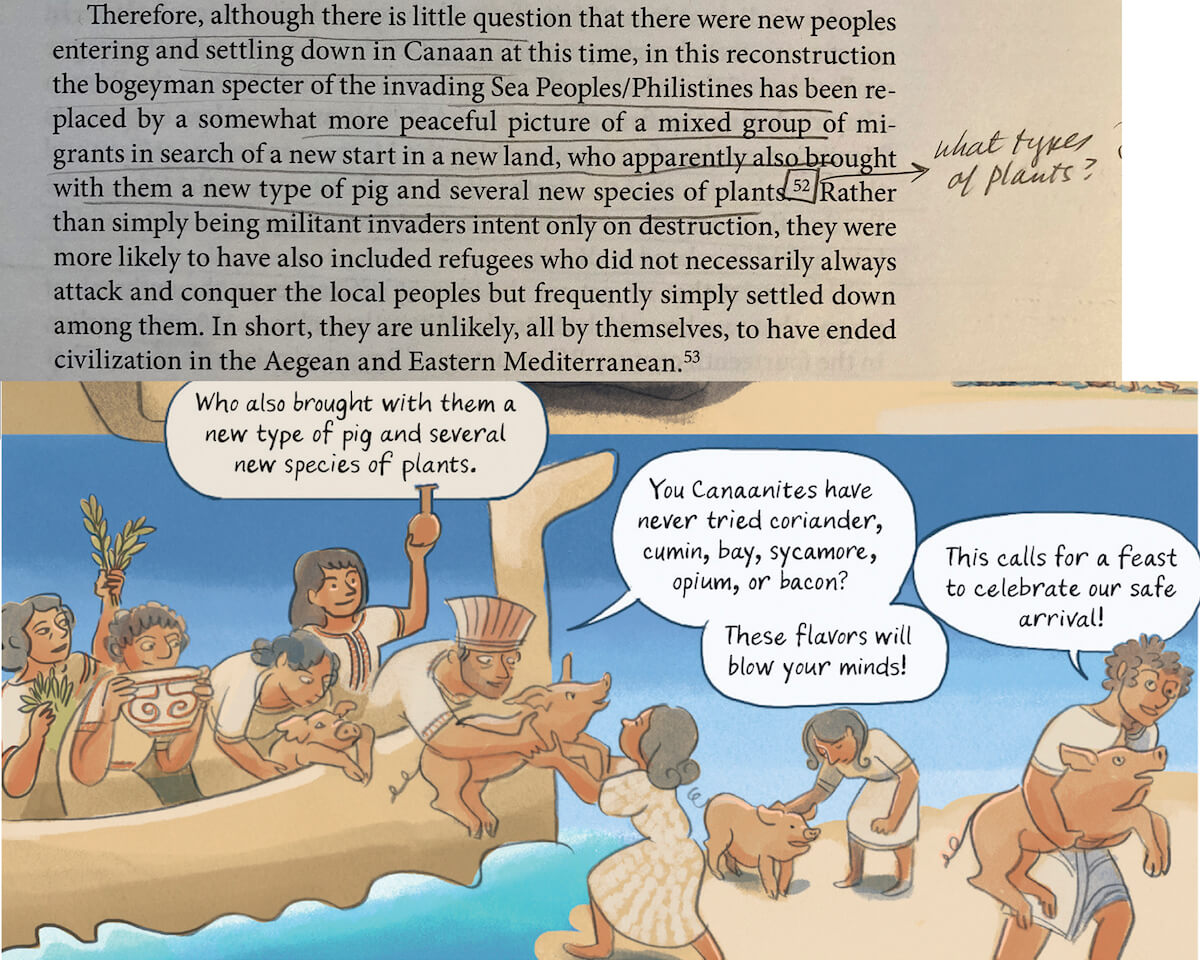
Above: An annotated passage from 1177 BC by Eric Cline about how the Philistines brought a new type of pig with them. Below: The comic book rendering of the above passage. Text and illustration by Glynnis Fawkes.
I employed images in several ways. Whenever Eric mentioned locations on a map, I drew one, by hand. You don’t want to use these maps for navigation, but I found it easier to draw maps by eye (in pencil on paper) than to try to digitally re-size and position maps to trace. Whenever Eric mentioned a monument or work of art, I drew it: the Colossi of Memnon, the bust of Nefertiti, the stele of Naram-Sin.
A third category is imagined scenarios — “what if?” situations. For example, Keliya, Chief Minister of Tushratta of Mittani (who appears in the Amarna letters) may have had a personal business trading alongside his official royal duties. I’ve drawn him leaving Amenhotep III’s palace, ready to make a deal with an assembled crowd concerning some multi-colored fuzzy wool pants (as listed in a letter from Amarna), among other goodies. Imagining this type of scene felt like playing on an ancient playground: Eric had constructed the framework; I sent the kids in to play. (Though situations at the end of civilization were dire — cities destroyed, many killed — I did not show the worst of the horror that must have been. It’s one thing to read about death and destruction, another to see it in graphic detail.)
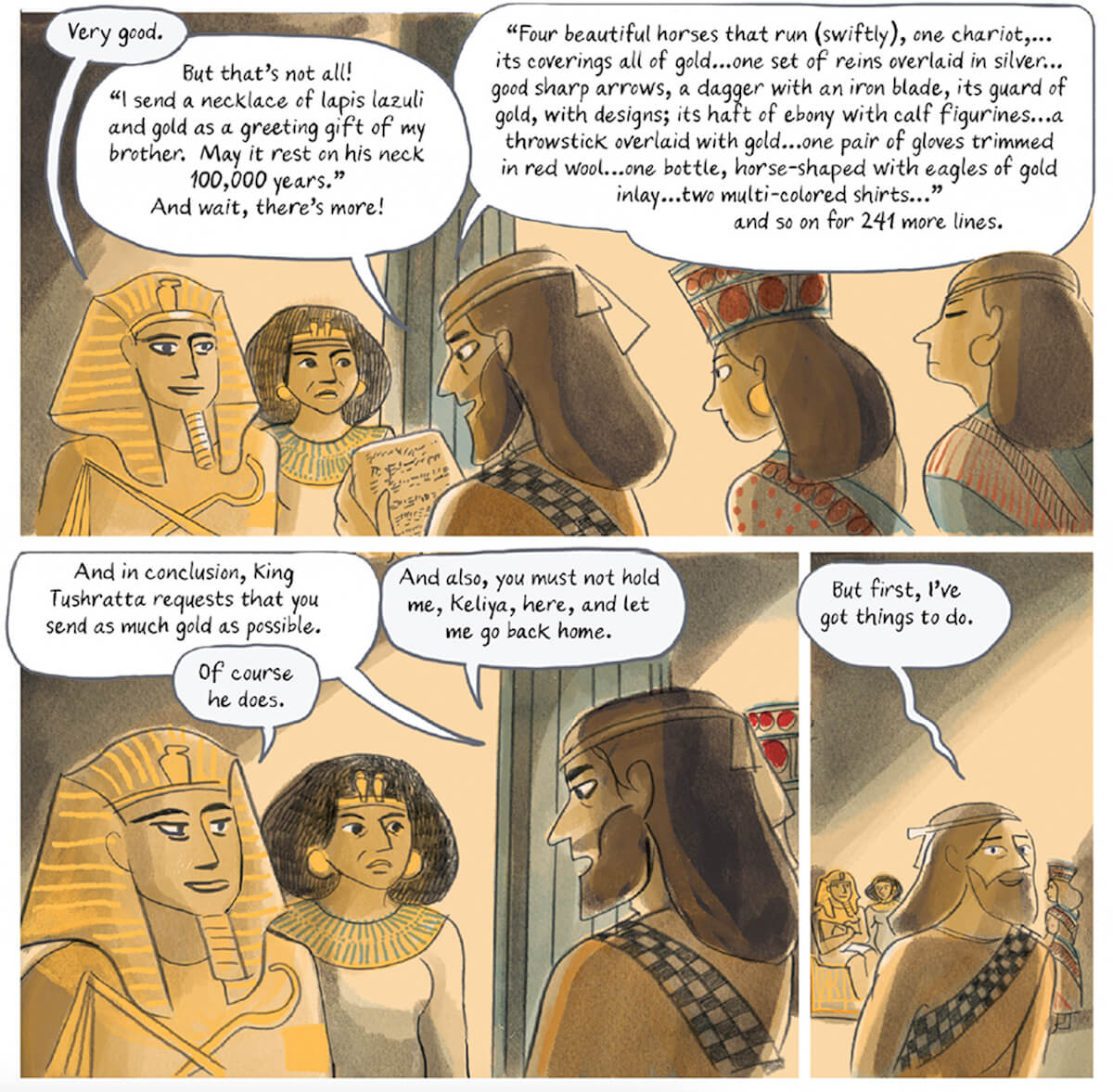
An exchange between Keliya, Chief Minister of Tushratta of Mitanni, and Amenhotep III. Text and illustration by Glynnis Fawkes.
The next stage was to pencil the pages, then to make final drawings on 11 x 14-inch paper, a size that allows for greater detail when reduced to the actual print size of the book. Referring to my thumbnails, I drew pages for the Prologue and Chapter 1, scanned them, added text in InDesign, and digital color on the iPad in Procreate.
At this point, for these first 50 pages, the narration appeared in impersonal text boxes. How to execute the verbal storytelling proved a little tricky. In Eric’s original book, his voice carries the narrative, but I resisted the idea of drawing Eric as a narrator character who would present information — I wanted to avoid imitating a TED talk or documentary film. Instead, I wanted to employ the unique powers of this visual medium: ancient characters could speak, and the story could be told through design and visual metaphor. Therefore, in my initial version, personalities of the past were already taking the stage: Ramses III, Sekhnenre, and so on. But no one character was asking the big questions: Why the collapse? And how did it happen? Nor any of the other sub-questions, like “Who are the Hyksos?” etc. Eric and I discussed the problem on a zoom meeting and came up with the idea of creating two new characters, “Pel” and “Shesha” — young residents of the 12th century BC — who would take up the big questions. This cracked the book’s story-telling code.
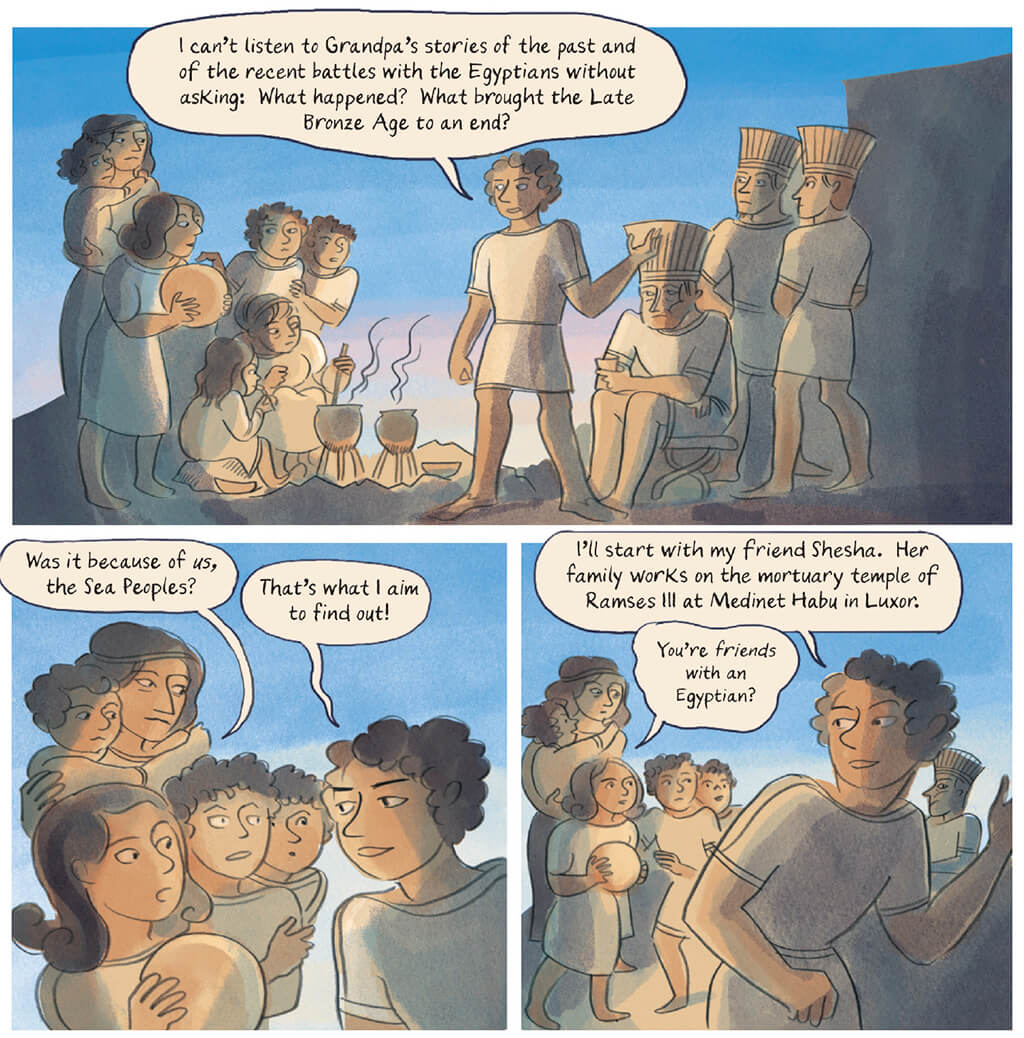
Eric and Glynnis created two new characters, Pel and Shesha, to be the anchors for the books story-telling. Image and text by Glynnis Fawkes.
The arrival of Pel and Shesha meant re-writing and re-drawing most of those first 50 pages, but it also launched a new adventure. Pel is a grandson of a veteran of the first Sea Peoples battles against the Egyptian army and is tired of hearing his grandpa tell stories of the glory days before the collapse. He leaves the cozy family fireside in a Sea Peoples’ camp to discover how and why the collapse happened. Pel’s friend Shesha is the daughter of Egyptian stone carvers and scribes, literate in all the necessary ancient languages, and in a position to investigate many of Pel’s questions. Through the magic of comics, they’re able to leap back in time to explore the cultures of the 15th, 14th, and 13th centuries BC to witness the building of connections: possible Minoan artists painting Thutmose III’s palace at Tel ed-Daba in Egypt, Amenhotep III’s harem of foreign princesses, the sinking of the Uluburun ship, Paris carrying Helen to Troy, and the Hittite invasion of Cyprus. Their dialogue was especially fun to write.
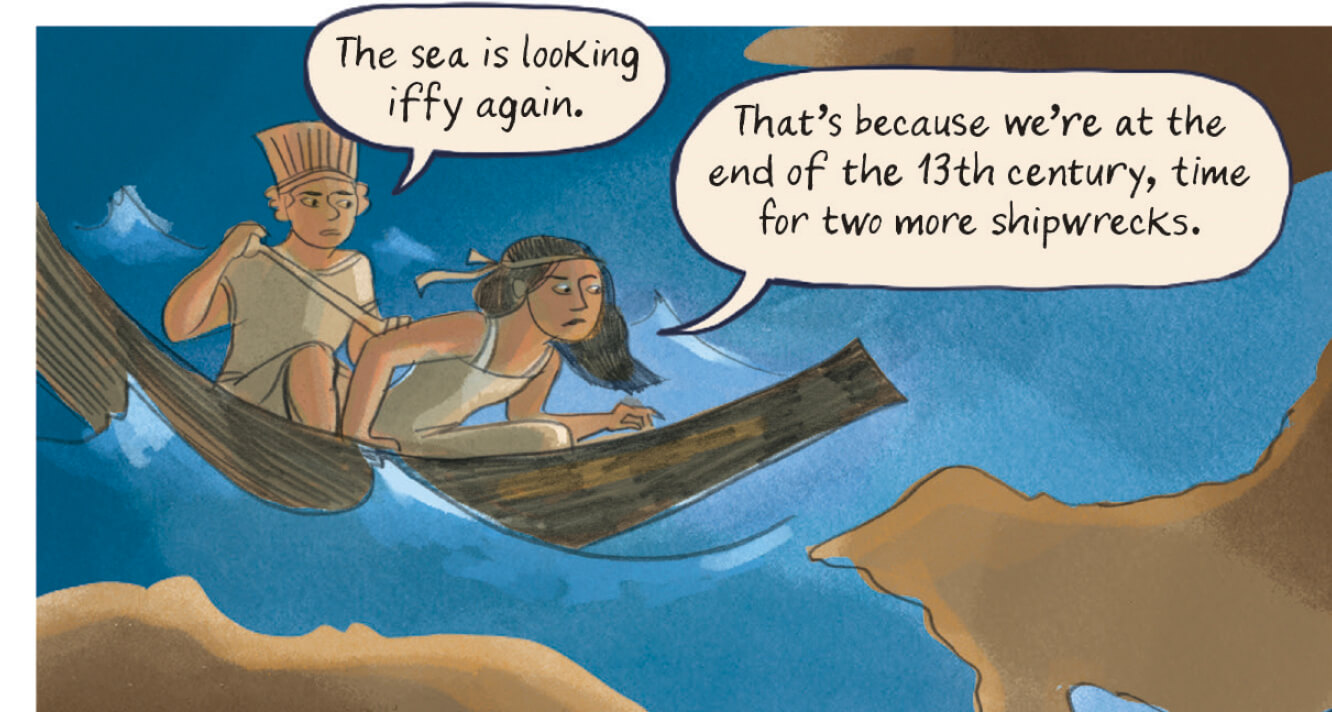
Pel and Shesha exploring the seas. Text and illustration by Glynnis Fawkes.
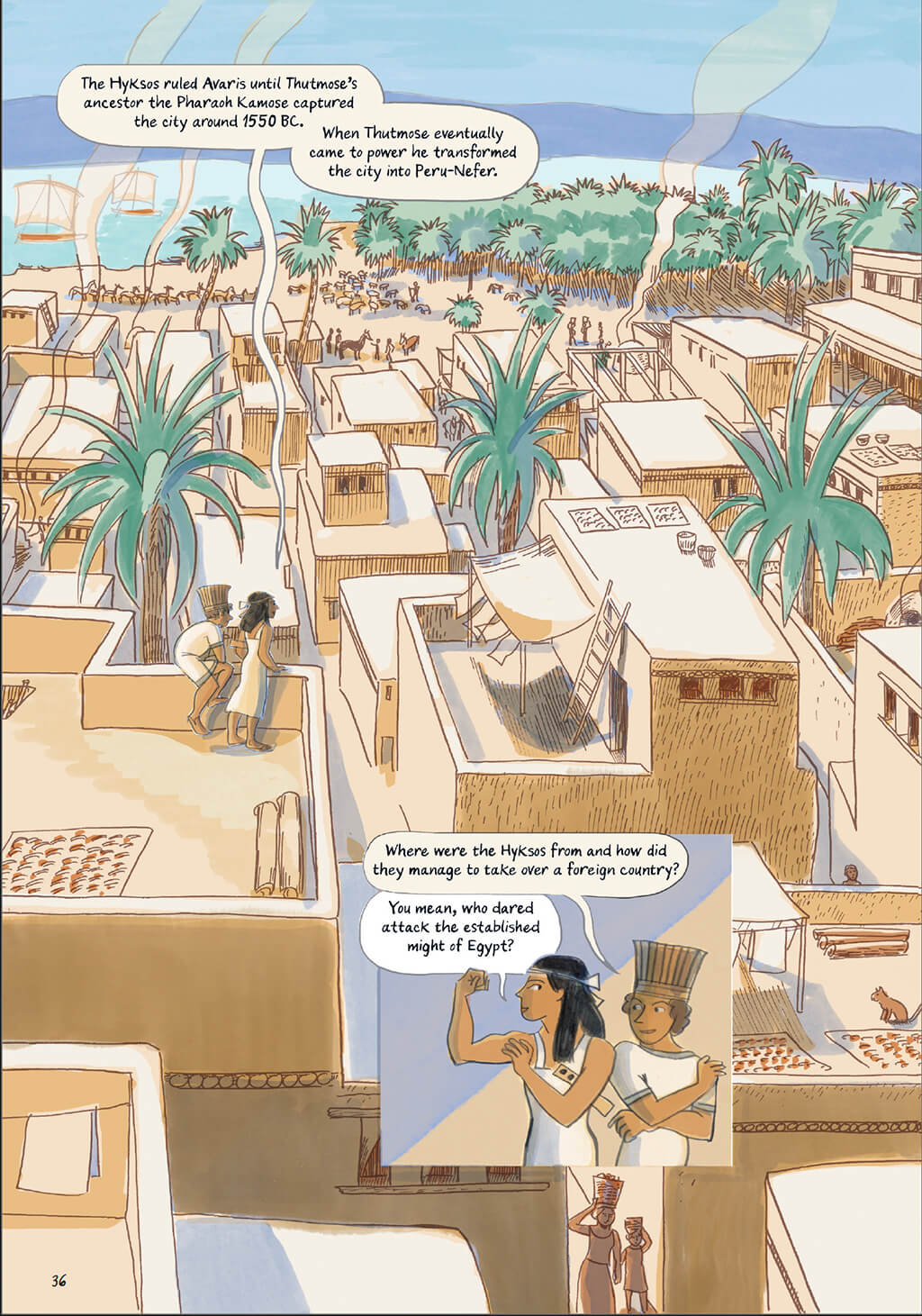
Pel and Shesha visit Avaris, the Hyksos capital. Text and illustration by Glynnis Fawkes.
It took about two months to retrofit Pel and Shesha into the first two chapters, and when I began moving forward again, the momentum was clear. Shesha is the guide, while Eric (and myself for conversational purposes) narrate the history of modern archaeological discovery. The story of 1177 BC is often about how archaeological theory and practice has changed over time, for example how the late 19th-century notion of the Sea Peoples as destroyers carried into 20th-century excavation reports, or how the methods of the (in)famous Heinrich Schliemann wouldn’t be acceptable today.
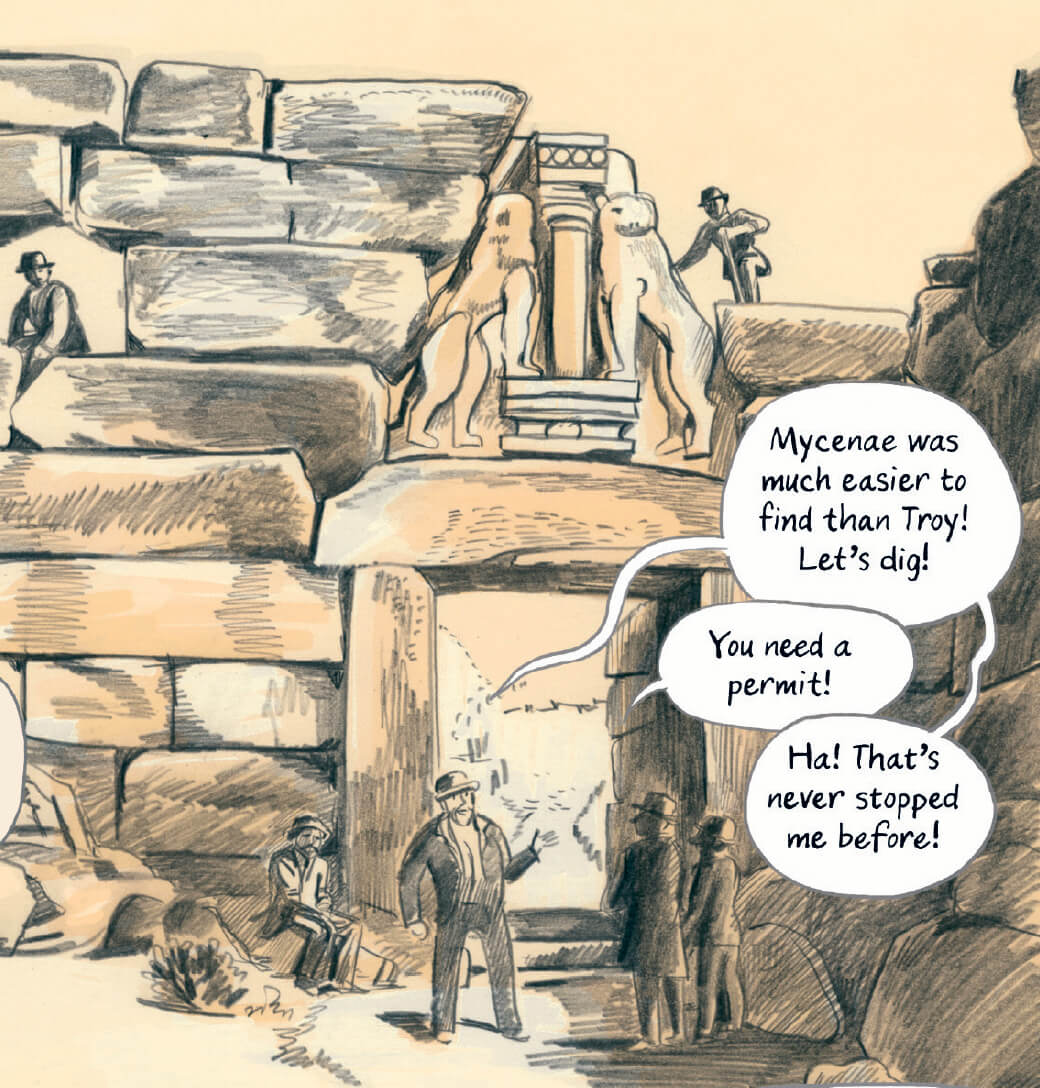
Schliemann arrives at Mycenae. Text and illustration by Glynnis Fawkes.
Pel and Shesha brought an extra emotional arc to the existing big questions presented in the book. Pel may not have received the definitive answers he was seeking — because of the limits of evidence and of our understanding— but he does return to his family with a more detailed and nuanced experience of the tremendous time that was 1177 BC.
Glynnis Fawkes is a cartoonist and archaeological illustrator. Her latest book is 1177 BC: A Graphic History of the Year Civilization Collapsed (co-authored with Eric H. Cline).
Want To Learn More?
Resilience and Rebirth: Lessons Learned from the Aftermath of the Late Bronze Age Collapse
By Eric H. Cline
Following the Late Bronze Age Collapse, different societies followed separate paths to recovery, while some didn’t recover at all. Do their examples hold any lessons for us today? Read More
ANE Today Extra: Tree Rings, Drought, and the Collapse of the Hittite Empire
By Eric H. Cline
The recent Nature study about drought and the fall of the Hittite Empire doesn’t just make for good headlines, it adds to our knowledge about the Late Bronze Age Collapse in fresh ways. Read More
